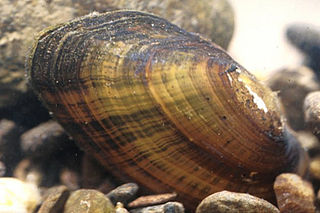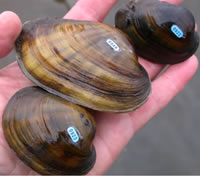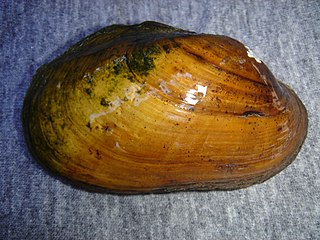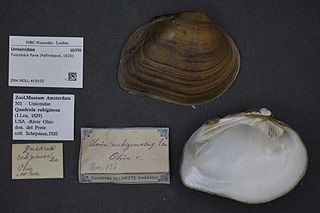
The dwarf wedgemussel is an endangered species of freshwater mussel, an aquatic bivalve mollusk in the family Unionidae, the river mussels.

The crystal darter is a species of freshwater ray-finned fish, a darter from the subfamily Etheostomatinae, part of the family Percidae, which also contains the perches, ruffes and pikeperches. This small North American fish is found in small, moderate, and swift rivers in the drainage basins of the Mississippi and Ohio Rivers. It is now extirpated from a majority of its range along the Ohio River.

The freshwater pearl mussel is an endangered species of freshwater mussel, an aquatic bivalve mollusc in the family Margaritiferidae.

Unionida is a monophyletic order of freshwater mussels, aquatic bivalve molluscs. The order includes most of the larger freshwater mussels, including the freshwater pearl mussels. The most common families are the Unionidae and the Margaritiferidae. All have in common a larval stage that is temporarily parasitic on fish, nacreous shells, high in organic matter, that may crack upon drying out, and siphons too short to permit the animal to live deeply buried in sediment.

The Appalachian elktoe is a species of freshwater mussel in the family Unionidae, the river mussels. It is native to the United States, where it is known only from North Carolina and Tennessee.

Cumberlandia monodonta is a freshwater mussel endemic to the United States. Currently, C. monodonta is listed as an endangered species by the U.S. Fish and Wildlife Service and the International Union for Conservation of Nature.

Epioblasma brevidens, the Cumberlandian combshell, is a species of freshwater mussel, an aquatic bivalve mollusk in the family Unionidae. This species is endemic to the United States, found mainly in the states of Tennessee and Virginia. This mussel resides in medium-sized streams to large rivers. The combshell is an endangered species and protected under the Endangered Species Act of 1973. The combshell is threatened by habitat modifications and pollution.

Lampsilis abrupta, the pink mucket or pink mucket pearly mussel, is a species of freshwater mussel, an aquatic bivalve mollusk in the family Unionidae, the river mussels. This species is endemic to the United States.

Lampsilis higginsii is a rare species of freshwater mussel known as Higgins' eye pearly mussel or simply Higgins' eye. It is endemic to the United States, where it occurs in the upper Mississippi River and the drainages of some of its tributaries. It is threatened by the introduced zebra mussel. Lapsilis higginsii is a federally listed endangered species.

Lampsilis powellii is a rare species of freshwater mussel known by the common name Arkansas fatmucket. It is endemic to Arkansas in the United States, where it occurs in the Ouachita, Saline, and Caddo River systems. It is one of two mussels endemic to Arksansas, the other being speckled pocketbook. It is a federally listed threatened species of the United States.
Lampsilis rafinesqueana, the Neosho mucket or Neosho pearly mussel, is a species of North American freshwater mussel endemic to Arkansas, Oklahoma, Illinois, Missouri and Kansas.

The Louisiana pearlshell, Margaritifera hembeli, is a rare species of bivalve mollusk in the family Margaritiferidae. This freshwater mussel is native to Louisiana in the United States, and was previously present also in Arkansas. It grows to a length of about 10 cm (4 in) and lives on the sand or gravel stream-bed in riffles and fast flowing stretches of small streams. Its life cycle involves a stage where it lives parasitically inside a fish. This mollusk is sensitive to increased sedimentation and cannot tolerate impoundments. Because of its limited range and its population decline, the International Union for Conservation of Nature has rated this mollusk as being "critically endangered".

Obovaria retusa is a rare species of freshwater mussel in the family Unionidae, the river mussels. Its common names include golf stick pearly mussel

Pleurobema oviforme, the Tennessee clubshell, is a species of freshwater mussel in the family Unionidae, the river mussels. It is native to the eastern United States, where it occurs in Alabama, Kentucky, North Carolina, Tennessee, and Virginia. It also previously occurred in Mississippi.

Potamilus capax, the fat pocketbook pearly mussel or fat pocketbook, is a species of freshwater mussel, an aquatic bivalve mollusk in the family Unionidae, the river mussels.
The triangular kidneyshell is a species of freshwater mussel, in the family Unionidae, the river mussels. It is endemic to Alabama in the United States, where it is known from several rivers and streams in the Mobile River Basin. It is a federally listed endangered species of the United States.
Ptychobranchus occidentalis is a species of freshwater mussel in the family Unionidae, the river mussels. It is endemic to the United States, where it is known from Arkansas, Kansas, Louisiana, Missouri, and Oklahoma. Its common name is Ouachita kidneyshell.
Obovaria arkansasensis, the Southern Hickorynut, is a species of freshwater mussel, an aquatic bivalve mollusc in the family Unionidae, the river mussels. It lives in the southern United States, and has a complex life history including its larvae being parasitic on a fish host.

Fusconaia flava, the Wabash pigtoe, is a freshwater mussel in the family Unionidae.

Megalonaias nervosa is a freshwater mussel species in the family Unionidae. Washboard is the common name used for Megalonaias nervosa.

















